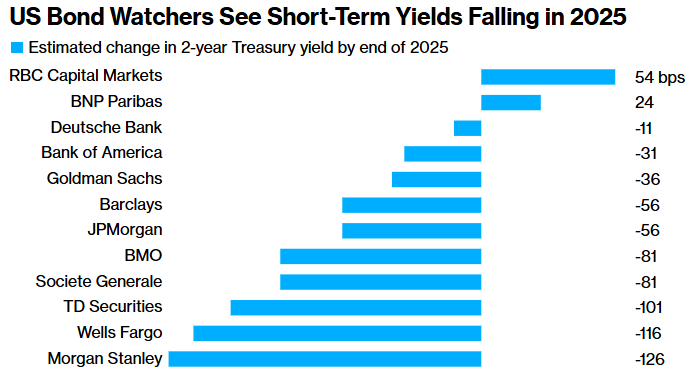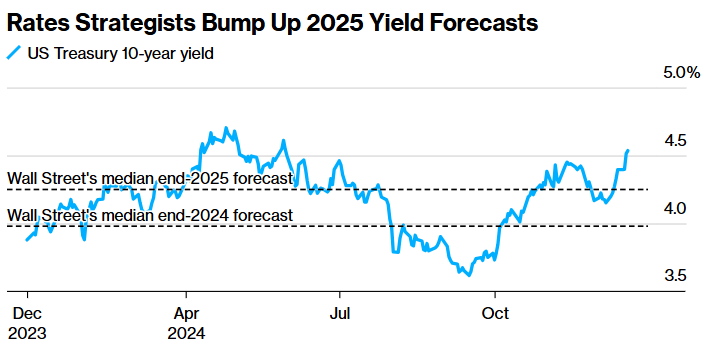Wall Street “agrees” with the Federal Reserve: predicts that 2Y US Treasury yields will fall by 50 basis points next year
Zhitong Finance learned that Wall Street is predicting that short-term US Treasury yields will fall in 2025, even though President-elect Trump's trade and tax policies pose an imminent threat to the bond market. The strategists' predictions are generally consistent, believing that the yield on 2-year US Treasury bonds, which are more sensitive to the Federal Reserve's interest rate policy, will fall. They expect that 12 months from now, interest rates will drop at least 50 basis points from current levels.
The J.P. Morgan Asset Management team, led by David Kelly, said in the company's annual outlook: “Although investors may be short-sighted about the speed and extent of interest rate cuts next year, investors should take a step back and recognize that the Federal Reserve will still cut interest rates in 2025.”

However, at this month's interest rate meeting, the Federal Reserve hinted that next year's interest rate cut will be smaller, which may complicate the yield trend. Currently, the median expectations of Federal Reserve officials suggest that the Fed will only cut interest rates by 50 basis points in 2025 — roughly equivalent to the 2-year US Treasury yield decline predicted by Wall Street — but this means there is a risk that the Fed's easing cycle will be suspended. After Federal Reserve Chairman Powell blamed inflation entirely on inflation, the yield curve rose sharply to its highest level since June 2022 on Thursday as investors reconsidered the value of holding longer-term bonds.
Tracey Manzi, senior investment strategist at Raymond James, said, “Given that the easing cycle is expected to be shorter, the front end of the curve will follow this trend. Any steepness we see will be dominated by the long end of the curve.”
The median forecast of 12 strategists is that the 2-year US Treasury yield will drop by about 50 basis points to 3.75% after one year. Just before the Federal Reserve released its latest economic forecast last week, this interest rate forecast had already climbed nearly 10 basis points. For longer-term 10-year US Treasury yield strategists expect it to reach 4.25% by the end of 2025, which is about 25 basis points lower than the current level.

Noel Dixon, macro strategist at State Street Bank, said, “No matter how you analyze it, whether judging from actual growth, inflation expectations, or term premiums, long-term treasury bonds will be under pressure.” Dixon has been predicting that 10-year US Treasury yields may rise above 5% by 2025.
They considered not only different views on how fiscal policy might evolve, but also the Federal Reserve's management of its US Treasury bonds. The central bank's end of balance-sheet contraction known as quantitative austerity may reduce bond supply and thus boost demand.
The Barclays team, led by Anshul Pradhan, wrote in a report: “Although the Federal Reserve may continue to lower policy interest rates and lower front-end yields, many factors that argue that long-term yields remain high: higher neutral interest rates, higher interest rate volatility, inflation risk premiums, and massive net issuance under price-sensitive demand.”
Bloomberg analysts Ira F. Jersey and Will Hoffman said: “If the economy stabilizes in early 2025, the Federal Reserve may cut interest rates slowly and may lower the interest rate cap to 4%. If the 10-year US Treasury yield does not hover between 3.8% and 4.7%, a major shift in the economy is likely to occur.”
Next is Trump's tariff and tax policies, which will be announced in the coming weeks, and could disrupt the future of Wall Street. Pradhan said, “Higher tariffs and tighter immigration controls will cause economic growth to slow, but increase inflation.”
Currently, Morgan Stanley and Deutsche Bank respectively hold the most optimistic and pessimistic views on the bond market.
Morgan Stanley believes investors will face “downside risks to economic growth” and an “unexpected bull market.” The company expects the Federal Reserve to cut interest rates faster than other banks, so the 10-year US Treasury yield is expected to fall to 3.55% in December next year.
Deutsche Bank, on the other hand, predicts that the Federal Reserve will not cut interest rates in 2025. The team led by Matthew Raskin expects the 10-year US Treasury yield to rise to 4.65% in the face of strong economic growth, low employment, and increased inflation. They wrote in a report: “We anticipate that the main factor contributing to our views is the recognition that inflation and job market conditions require the Federal Reserve to adopt stricter policies than current pricing.”
 Index Options
Index Options CME Group
CME Group Nasdaq
Nasdaq Cboe
Cboe TradingView
TradingView Wall Street Journal
Wall Street Journal